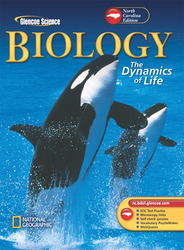 
Biology: The Dynamics of Life, North Carolina EditionChapter 21:
What is a plant?Web Links
| Click the Techie Toolbox for tips and help to make the most of your time on the Web.
 <a onClick="window.open('/olcweb/cgi/pluginpop.cgi?it=gif::::/sites/dl/free/0078675642/181784/techietoolbox.gif','popWin', 'width=NaN,height=NaN,resizable,scrollbars');" href="#"><img valign="absmiddle" height="16" width="16" border="0" src="/olcweb/styles/shared/linkicons/image.gif"> (2.0K)</a> <a onClick="window.open('/olcweb/cgi/pluginpop.cgi?it=gif::::/sites/dl/free/0078675642/181784/techietoolbox.gif','popWin', 'width=NaN,height=NaN,resizable,scrollbars');" href="#"><img valign="absmiddle" height="16" width="16" border="0" src="/olcweb/styles/shared/linkicons/image.gif"> (2.0K)</a>
p. 558
 <a onClick="window.open('/olcweb/cgi/pluginpop.cgi?it=gif::::/sites/dl/free/0078675642/181784/biology_online.gif','popWin', 'width=NaN,height=NaN,resizable,scrollbars');" href="#"><img valign="absmiddle" height="16" width="16" border="0" src="/olcweb/styles/shared/linkicons/image.gif"> (1.0K)</a> <a onClick="window.open('/olcweb/cgi/pluginpop.cgi?it=gif::::/sites/dl/free/0078675642/181784/biology_online.gif','popWin', 'width=NaN,height=NaN,resizable,scrollbars');" href="#"><img valign="absmiddle" height="16" width="16" border="0" src="/olcweb/styles/shared/linkicons/image.gif"> (1.0K)</a>
| | The Mysterious Venus Flytrap | | Access this site to learn about one type of “carnivorous” plant. What sort of adaptations do Venus flytraps have in order to get energy?
(
http://www.botany.org/bsa/misc/carn.html
) |  |  |  | | The Growing Edge | | Visit the Growing Edge website to learn about hydroponics. What does hydroponics mean? How is growing plants with hydroponics different than growing plants in a garden? Investigate how you can build your own hydroponics growing system.
(
http://www.growingedge.com/kids/
) |  |  |  | | Plants Database | | The USDA maintains a complete site of plants found in the United States. Use the common name search to find information about plants from your area. With a small group, make a computer presentation, identifying various types of plants and their distribution. Be sure to include whether the plant is native or not.
(
http://plants.usda.gov/
) |  |  |  |
p. 571
 <a onClick="window.open('/olcweb/cgi/pluginpop.cgi?it=gif::::/sites/dl/free/0078675642/181784/biolab.gif','popWin', 'width=NaN,height=NaN,resizable,scrollbars');" href="#"><img valign="absmiddle" height="16" width="16" border="0" src="/olcweb/styles/shared/linkicons/image.gif"> (1.0K)</a> <a onClick="window.open('/olcweb/cgi/pluginpop.cgi?it=gif::::/sites/dl/free/0078675642/181784/biolab.gif','popWin', 'width=NaN,height=NaN,resizable,scrollbars');" href="#"><img valign="absmiddle" height="16" width="16" border="0" src="/olcweb/styles/shared/linkicons/image.gif"> (1.0K)</a>
| | Native Conifers of North America | | This site contains information about conifers. Go to the key for genera and species and see how it compares to the dichotomous key you made. Find out about one of the "remarkable" conifers and design a flyer to inform your classmates about your selected conifer.
(
http://www.nearctica.com/trees/conifer/
) |  |  |  | | Conifer Society | | The American Conifer Society’s website has a introduction to conifers and their many uses. Find out what the difference in the average annual growth is between miniature and large conifers. Follow the “links of interest” to learn where you might purchase conifers.
(
http://www.conifersociety.org/coniferinfo_frame.html
) |  |  |  |
p. 572
 <a onClick="window.open('/olcweb/cgi/pluginpop.cgi?it=gif::::/sites/dl/free/0078675642/181784/connection2health.gif','popWin', 'width=NaN,height=NaN,resizable,scrollbars');" href="#"><img valign="absmiddle" height="16" width="16" border="0" src="/olcweb/styles/shared/linkicons/image.gif"> (2.0K)</a> <a onClick="window.open('/olcweb/cgi/pluginpop.cgi?it=gif::::/sites/dl/free/0078675642/181784/connection2health.gif','popWin', 'width=NaN,height=NaN,resizable,scrollbars');" href="#"><img valign="absmiddle" height="16" width="16" border="0" src="/olcweb/styles/shared/linkicons/image.gif"> (2.0K)</a>
| | Medicines That Changed the World | | Read this online article to learn the history of some important medicines and the plants they came from. Find out how quinine from the cinchona tree helps malaria victims, and how bromlain (a pineapple enzyme) may help heart attack patients.
(
http://www.accessexcellence.org/RC/Ethnobotany/page4.html
) |  |  |  |
p. 575
 <a onClick="window.open('/olcweb/cgi/pluginpop.cgi?it=gif::::/sites/dl/free/0078675642/181784/real_world_bio.gif','popWin', 'width=NaN,height=NaN,resizable,scrollbars');" href="#"><img valign="absmiddle" height="16" width="16" border="0" src="/olcweb/styles/shared/linkicons/image.gif"> (1.0K)</a> <a onClick="window.open('/olcweb/cgi/pluginpop.cgi?it=gif::::/sites/dl/free/0078675642/181784/real_world_bio.gif','popWin', 'width=NaN,height=NaN,resizable,scrollbars');" href="#"><img valign="absmiddle" height="16" width="16" border="0" src="/olcweb/styles/shared/linkicons/image.gif"> (1.0K)</a>
| | Bloomingdoor Lawn and Garden Guide | | Visit this site for links to the many aspects of planning, planting, and caring for flower gardens.
(
http://www.bloomingdoor.com/seasonal.html
) |  |  |  | | Right Plant in the Right Place | | The Magical Garden of Disney has tips on how to start a flower garden. What do you look for, how do you plan it, and how do you choose the right plants?
(
http://www.mouseplanet.com/dtp/gardens/2_General/right.htm
) |  |  |  | | Emily Compost | | How important are gardening zones and growing seasons? Find out by reading information at this website. Follow the link to the USDA Plant Hardiness Zone Map and determine what zone you live in before you plan your flower garden.
(
http://www.emilycompost.com/zones.htm
) |  |  |  |
 |  |
|







